With its unique ‘lamb-like’ looks and playful, attention-seeking personality, the Bedlington Terrier is a head-turner. Originally bred as a vermin hunter, the breed is now widely praised as a show dog and a fun and active companion.
Good with older kids, the Bedlington has a true terrier instinct but is also a gentle soul that loves nothing better than a cuddle with his human. But he does need plenty of exercise and stimulation. So, if you are looking for a smart pooch that is low-shedding and great company, then read on, as the Bedlington Terrier could be the one for you.
Breed Overview
- Dog Breed Group: Terrier
- Height: 16-18in (male) and 15-17in (female) to the shoulder
- Weight: 17 – 23 pounds
- Life Expectancy: 12-16 years
Short History of the Bedlington Terrier
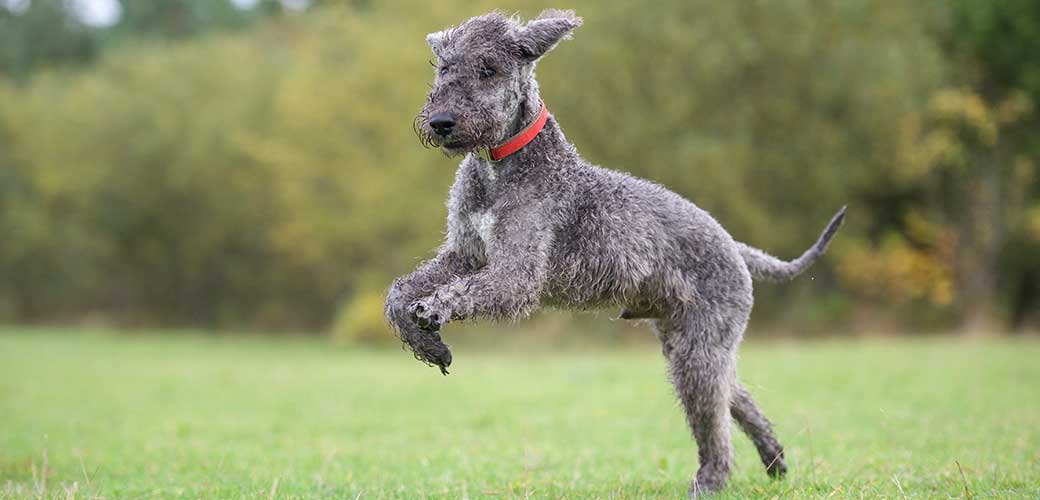
Compact and energetic, the Bedlington Terrier originates from Northumberland, England and can be dated back to around 1825. The breed is a descendant of the Rothbury Terrier, prized by the local gypsy communities for its ability to hunt, mainly foxes, badgers, and rats. The Bedlington is also thought to have the Otter Hound and the Dandie Dinmont Terrier in their breeding DNA.
The first Bedlington Terrier – Piper – was bred by Joseph Aynsley in the village of Bedlington, hence the name. Piper was a prolific hunter, catching its first badger at eight months, and carried on hunting well into old age.
During the 19th century, the Bedlington was a dual-natured canine; renowned for its hunting and fighting prowess, the breed was also known for its sweet temperature away from the field or dog fighting ring. This meant that Bedlington Terriers also became sought after as family companions and watchdogs, often for the upper classes, thanks to their trainable and well-behaved demeanor. As a working dog, the Bedlington was also a prolific vermin hunter and was frequently used in coal mines and factories of the 19th century.
The transformation of the Bedlington into a fully-fledged companion and show dog started in the early 1900s, which also saw new methods of grooming, giving the breed its distinctive lamb-like head and face.
The breed crossed the Atlantic in the 1920s and steadily grew in popularity as a pet. The present-day breed, larger than the dog in its early days, was eventually recognized as a breed by the American Kennel Club in 1967.
Breed Facts
Before we delve deeper into this gorgeous breed, here’s a summary of some essential Bedlington Terrier facts.
- The Bedlington is a hypoallergenic breed as its curly coat is very low shedding, so it is ideal for dog owners who have allergies. However, that woolly coat is fast growing, so they require a lot of grooming and coat maintenance.
- While they have a warm and friendly personality, the Bedlington Terrier is also known to be stubborn – they are a terrier at heart, after all! They are also very vocal, so you may need to consider your neighbors before bringing one into your home.
- Bedlington Terrier puppies are all born either black or brown. As they grow, their coat will start to lighten and reveal their true color – usually blue, sandy, liver, or tan.
- They don’t have that typical terrier look but are distinct thanks to their narrow, arched head, strange curly coat, and roach (arched) back.
- As well as being expert vermin hunters, the Bedlington is also a prolific swimmer and loves to be in the water.
- The Bedlington was favored by some famous people – the breed was kept and bred by film actor Boris Karloff, who was best known for playing Frankenstein in the 1931 movie. And the Rockefeller family owned and bred Bedlington Terriers in the 1940s.
- Despite his sweet lamb looks, the Bedlington is not one to back down from a fight. They don’t like to be dominated by other dogs and will retaliate if pushed.
How Big Does a Bedlington Terrier Grow?
The Bedlington Terrier is considered a small-medium dog, although his long limbs give the impression that they are taller.
- Bedlington Terrier size – An adult male Bedlington reaches an average height of 16-18 inches (to the shoulder), while the female is a little smaller at 15-17 inches. Weight-wise, a healthy adult dog should be between 17 and 23 pounds, depending on their size.
- The Bedlington Terrier coat – A Bedlington can also look a little larger than they are, thanks to that wonderfully woolly and wiry coat. This low-shedding short coat is curly like sheep and is a mix of hard and soft hair that fills out the bone structure underneath. The dog hair also thickens more on the roman-shaped muzzle and front legs, creating a sense of even more volume. His tapered tail, fluff-ball end to his ears, and springy gait give him a slightly comical look that matches his fun and loving personality.
Bedlington coat colors are sandy, liver, blue, tan, blue and tan, and sandy and tan markings. Bedlington blue is the most popular color for the breed.
Bedlington Terrier Temperament

As a terrier, the Bedlington is an independent and smart canine with an alert and intelligent personality that can also border on stubbornness if allowed. They are relatively high-energy but, unlike many terrier breeds, have a calmer demeanor and are just as happy snuggling on the sofa. However, they enjoy exercise, play well with children, and need plenty of stimulation, making them a good choice for an active family.
The Bedlington Terrier temperament means that they love attention, are known to be a show-off, and will be outgoing with visitors to your home. They love people and so can suffer from separation anxiety if left alone for too long. But they are also astute when it comes to making friends, and this makes them excellent watchdogs.
Overall, the Bedlington Terrier will get along with dogs and other pets, especially if they have been raised with them. But do remember that they don’t respond well to acts of dominance and are known not to back down if attacked or confronted by other alpha dog breeds. And that terrier instinct means they can chase small animals and pets.
Do Bedlington Terriers bark a lot?
A lover of life, the Bedlington likes to tell you exactly what they think and to get your attention. As a breed, they do like the sound of their voice. This means that without positive training or having their needs met, they can become more of an excessive barker.
Taking steps to reduce boredom and minimize the triggers for habitual barking can bring your Bedlington back to a more normal level. But if you are struggling with excessive barking in your Bedlington, it’s a good idea to seek expert help.
How do you keep a Bedlington Terrier entertained?
As a clever, active breed, the Bedlington Terrier can be prone to boredom, resulting in unwanted, even destructive behavior. But the good news is that the Bedlington loves to play and is a joy to keep entertained.
Ensure your pooch has plenty of play sessions that stimulate his mind and burn off that energy. They respond particularly well to games that cater to their terrier instinct, so make sure they get plenty of time playing fetch and chase.
Do Bedlington Terriers like water?
While not bred as water dogs, most Bedlington Terriers are happy in the water and can be powerful swimmers. A Bedlington may not be a true water lover just for fun, but it won’t deter them from getting where they want to be, especially if they are hunting their prey.
Do Bedlington Terriers like to cuddle?
It’s fair to say that the Bedlington Terrier dog breed is cuddly in looks and also cuddly by nature. Yes, they are active, smart, and on the go, but they also have a lovely gentle side to their character. And this comes out come sofa time when you’ll find him ready to hunker down with his favorite human.
Are Bedlington Terriers easy to potty train?
While the Bedlington is known to be intelligent, they also have a stubborn side so are not amongst the easiest dog breeds to train. However, potty training should not be too much of a problem, as long as you start early enough and are consistent with what you need them to do. Patience, positive reinforcement, and treat rewards will all reap the rewards when it comes to getting them to go potty outside.
How to Care for Bedlington Terrier
Confident, intelligent, and sociable, the Bedlington Terrier is relatively low maintenance regarding its care routine. But it is important to recognize certain traits in Bedlington’s personality to ensure they meet all their needs and can live a full, happy and healthy life. Here’s our guide to caring for your new Bedlington Terrier.
Are Bedlington Terriers easy to train?
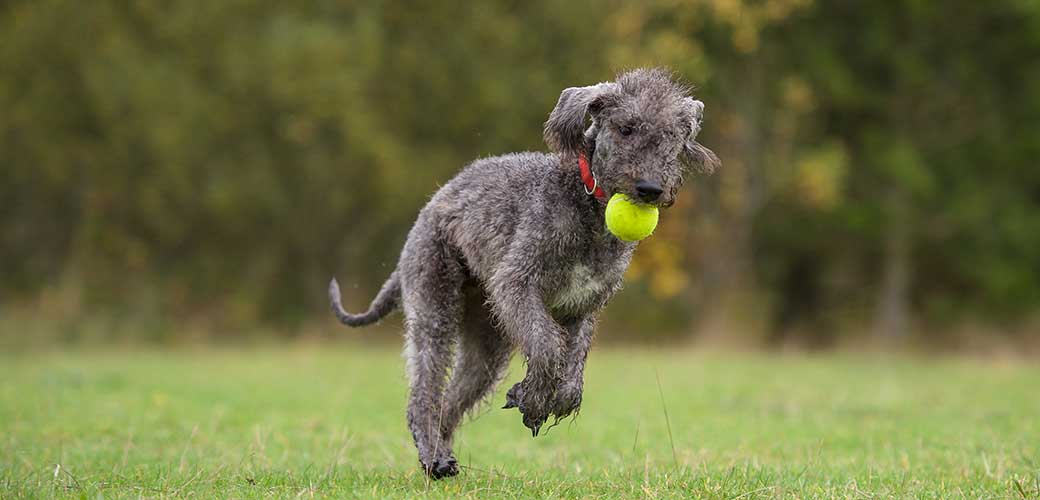
Even though they are eager to please and with a smart brain, the Bedlington is only considered relatively easy to train. And is because of their tendency for stubbornness and the ease at which they can get bored.
Fine-tuning your approach towards training a Bedlington should help to negate these issues. You need to start early, as Bedlington Terrier puppies are more amenable to obedience training and socialization. A puppy kindergarten class can be a good idea. Your approach also needs to keep your pup’s attention, which means food rewards and positive reinforcement training work well. Bedlingtons simply don’t respond well to harsher training methods, and you could find yourself caught up in a battle of wills.
As the Bedlington Terrier excels at dog sports, such as agility and flyball, incorporating these into his ongoing training and development can also focus that terrier brain and reap some excellent rewards.
How much exercise does a Bedlington Terrier need?
As a smaller medium-sized dog, a Bedlington Terrier is a good apartment dweller in homes with more outdoor space. But to keep them healthy and happy, the Bedlington Terrier does need a decent amount of exercise, at least one hour a day. regular exercise can also help to manage their energy levels and prevent boredom. As well as walks in the park, consider hikes, games, and agility or obedience classes for variety and mental stimulation.
Just be mindful of letting your Bedlington Terrier off its leash safely, as their terrier instinct means they could chase after small animals in open spaces.
What food do Bedlington Terriers eat?
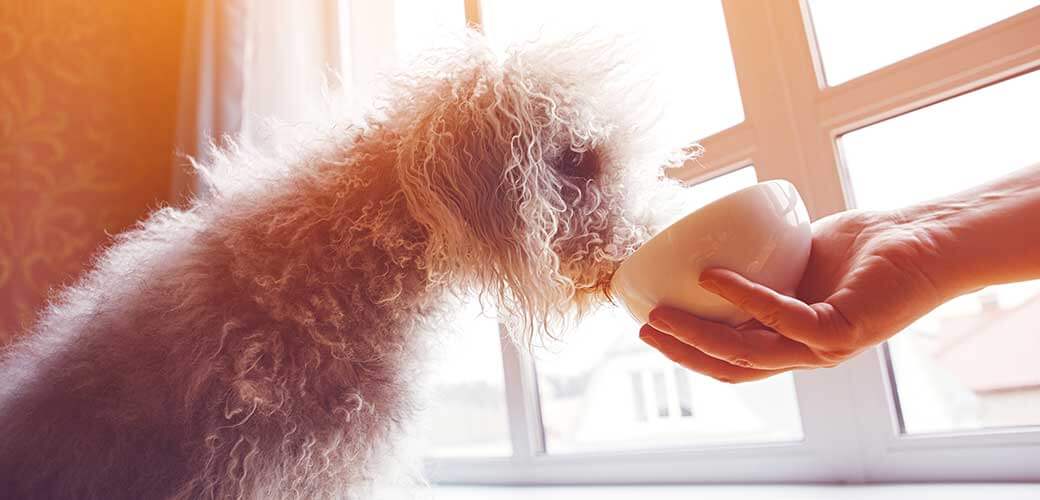
As an energetic breed, you need to ensure their diet provides sufficient calories and quality protein and nutrients to sustain their daily life on the go. And this means you should only give them high-quality dog food containing all the essential vitamins, minerals, fiber, and good fats to support their health.
How much should you feed a Bedlington Terrier?
The recommended daily amount of food for an adult Bedlington Terrier is 1 to 1.5 cups of dry dog food per day, split over two meals. Bedlington Terrier puppies need to be fed smaller meals four times a day.
Always ensure the amount of dog food you feed is appropriate to your dog’s size, activity levels, and age.
Do Bedlington Terriers shed a lot?
The woolly lamb look of Bedlington Terriers is deceptive, this is a breed considered to be a low-shedder. This is good news for owners allergic to pet hair or don’t want fur all over their furniture. The Bedlington coat will shed a little but will require extra grooming help to keep him comfortable and looking his best.
How do you groom a Bedlington Terrier?
The low-level shedding of the Bedlington does have a downside – they need extra help to reduce their fur and prevent matting and tangles. And this means you’ll need to regularly take your pet to a professional dog groomer.
Their hair will need to be clipped roughly every two months, and their coat brushed at least twice a week in-between visits to the doggy parlor. Unlike other terriers, there is no need to hand-strip the coat of the Bedlington to remove dead hair, as regular grooming should do the trick.
When grooming your Bedlington Terrier, it is a good idea to check their nails and trim if needed. Checking their ears and teeth can also highlight the need for a little extra cleaning.
Why are Bedlington Terriers shaved?
As the Bedlington Terrier’s coat grows quickly and doesn’t really shed, a trip to a professional groomer for a clip or shave is recommended, normally every two months. This also gives your Bedlington’s coat the iconic ‘lamb clip’ and helps to keep their coat healthy and in top condition.
Do Bedlington Terriers have hair or fur?
The Bedlington Terrier dog breed has a single-layered coat, similar to poodles, so is considered to have hair. Fur is normally when a dog has a double coat for extra insulation. With the Bedlington, however, you get two types of hair – harsh and soft – which creates that distinctive crispy and curly coat that looks thicker than it is.
Are Bedlington Terriers Healthy?
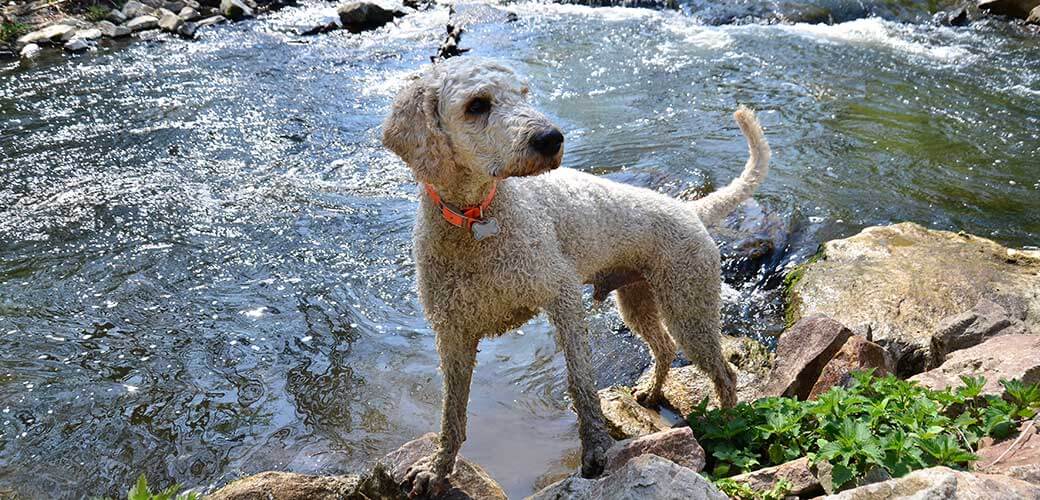
Like most purebred dogs, Bedlington Terriers can be susceptible to some health conditions and genetic health problems common to the breed. But generally, Bedlington Terrier health is good.
When buying Bedlington puppies, it is important to be aware of the main health issues which may affect your pet, which include:
Copper toxicosis
This genetic disorder largely causes copper to build up within the dog’s liver and bloodstream. Left untreated, this can lead to liver failure and death. Copper toxicosis typically appears in a Bedlington Terrier dog between the ages of two and four. It is an inherited condition, and it is possible to screen for affected dogs who may be carriers.
Progressive retinal atrophy
Bedlington Terriers are also prone to eye issues, particularly progressive retinal atrophy. This inherited condition progresses from age five, leading to night blindness and eventual full blindness. Bedlington Terriers can also be prone to retinal dysplasia, which causes abnormal development of the dog’s retina. Checks on Bedlington’s breeder and their stock for this condition can be made through the Canine Eye Registry Foundation.
Exocrine pancreatic insufficiency
This disorder means a dog’s pancreas cannot develop sufficient digestive enzymes to effectively absorb nutrients. This can lead to weight loss, skin issues, and frequent diarrhea. It can, however, be treated with dietary supplements.
Hyperadrenocorticism or Cushing’s disease
Bedlington Terriers are more prone to Cushing’s than other dog breeds. With this disease, the adrenal glands malfunction and produce too many steroid hormones. Symptoms include excessive thirst and appetite, lethargy, and hair loss. Fortunately, it can be treated with a medication program.
Hip dysplasia
A deformity in the growth of the hip joint, hip dysplasia can affect most dogs and lead to reduced mobility and arthritis.
When buying a new Bedlington Terrier puppy, the National Bedlington Terrier Club recommends checking with the breeder whether the parents have been screened for these inherited conditions.
How long do Bedlington Terriers live?
The Bedlington Terrier is one of the healthier dog breeds and enjoys an active and varied lifestyle. This means they also have an above-average life span of between 12 and 16 years. There are also records of Bedlingtons living beyond 17 years, so you can expect many years of love and fun with your new Bedlington furry friend.
How to Find a Good Breeder
When buying a Bedlington Terrier puppy, you must only go to reputable breeders, not a puppy farm. So, it is important to do your homework to know you have found a good breeder. One of the numerous breed groups, such as the National Bedlington Terrier Club, the Bedlington Terrier Club of America, or the American Kennel Club, is a good place to start, as they will hold lists of registered Bedlington Terrier breeders.
When visiting a litter of Bedlington puppies, always ask to see their parents and grandparents if possible, and request evidence of their health and documented health clearances.
Adopt a Dog From a Rescue Center or Shelter!
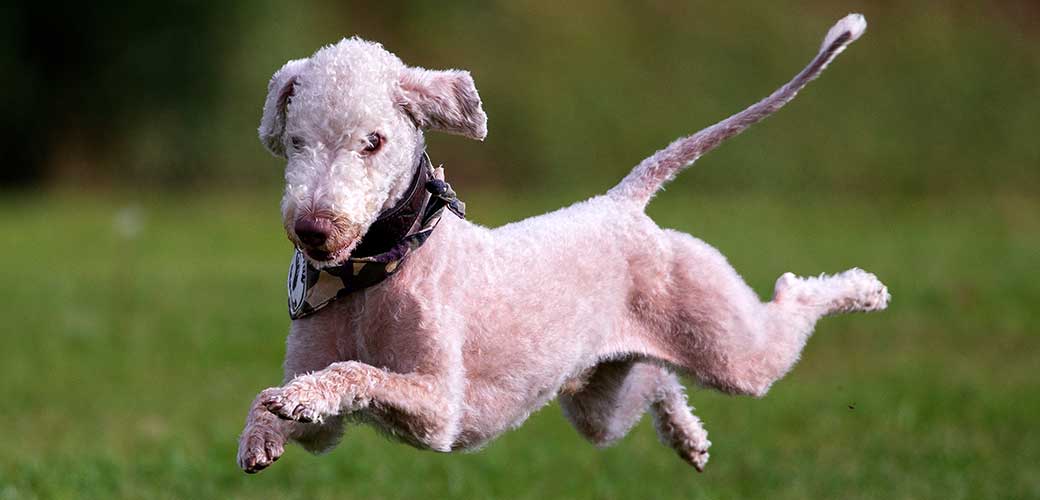
Adopting rather than shopping for your new dog can be a hugely rewarding and positive experience. And while they are pure breed, it is possible to find Bedlington Terriers in a rescue center or up for adoption.
As we have seen, Bedlington Terriers are sociable and friendly animals, but they can be stubborn, and their terrier’s hunting instinct can be strong. This means some families may have underestimated what is involved in owning this gorgeous breed or discovered their new pet cannot live with other dogs or smaller pets. And this may be the reason why a Bedlington finds itself up for adoption.
Speak to your local animal rescue center to learn more about adopting a Bedlington Terrier. Alternatively, you can get in touch with one of the national dog rescue organizations, or the Bedlington Terrier Rescue America, who can potentially point you in the right direction.
What is the Average Price for a Bedlington Terrier?
If you have decided that the Bedlington Terrier is the perfect canine to add to your life, you should expect to pay the price. Bedlington Terrier puppies are currently between $1,500 and $2,500, depending on their breeding and parentage. Potential show dogs can be as high as $5K.
And don’t forget, the initial outlay to buy your new Bedlington pup is just the start as you will also need to budget for their care, feed, and health for the rest of their lives, which can be 16 years plus. But if your math adds up and you are ready to take the plunge, then a Bedlington will add a lot of joy, mental stimulation, and love to your life!
Source:
- The Bedlington Terrier breed standard – American Kennel Club

